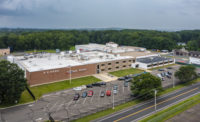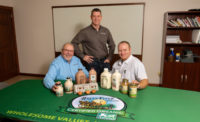
“We have state-of-the-art technology on every system in the plant,” says Jason Schultz, cheese manufacturing manager at Sartori Foods’ Plymouth, Wis., plant.
From automated recipes to track and trace, technology at the 70-year-old facility is up there with the best of them. But beyond the high-tech appliances to ensure quality and safety, Sartori’s fine Italian cheeses couldn’t approach their world-class levels unless their master cheesemakers applied their hands-on skills to each vat of cheese.
“Even though the plant is automated, we want the cheesemakers to interact with the milk, to see how it’s performing,” says Pat Mugan, vice president of product innovation.
Schultz adds: “Within this plant, we have well over 150 years of cheesemaking experience.”

Secret's in the starter
Tankers filled with Wisconsin milk enter the receiving bay on the plant’s west side. After passing standard testing – including antibiotics, acidity and temperature – the milk is unloaded into the four raw receiving tanks.Milk must be less than 45 degrees F to be accepted, Schultz says. “We cool our milk further to 40 degrees before it goes into our silos and we have to use it within 24 hours,” he explains. “It’s all about quality ingredients.”
Unloaded tankers pull forward to be cleaned. How many trucks call on the plant each day depends on production needs, Schultz says: “We open at 5 a.m. and take in milk until 5 p.m. It is usually busy all day.”
Sartori’s Plymouth plant draws milk from family farms within a radius of 60 to 75 miles – as far north as Green Bay, west to Fond du Lac and south to Port Washington.
“We want the old-world way of making cheese, where the milk doesn’t travel a long distance and the fats start breaking up,” Mugan says. “It makes a difference to the flavor of our cheese.”
The company has a field team to work closely with patron farms on a milk quality program. “Our business really starts at the farms,” says Jim Sartori, chief executive officer, “and some farms have shipped to us for 50 years. We only source milk from local family farms. We have very strong relationships and have worked very hard partnering to deliver the finest milk quality level possible.”
From raw receiving, milk travels upstairs to the cheese make area. First comes pasteurization, after which the temperature of the milk is taken down to about 90 degrees. The milk is then standardized to the type of cheese being made; sweet cream is pulled off, cooled and stored.
Next stop is the plant’s most highly guarded area, the starter room. Mechanically, it contains five starter vats. Beyond that, its contents are highly secretive because of Sartori’s proprietary culture strains used for its unique varieties of specialty cheeses.

Mugan adds: “This sets us apart right here – we have proprietary strains to give us special flavors and textures. This is really the key.”
The inoculated milk is pumped into three double-O vats, where Schultz says the plant’s technical and artisanal sides meet. All the recipes are automated, but it’s up to the keen senses of the plant’s nine licensed master cheesemakers, two of whom are Certified Master Cheesemakers, to know exactly when to take each batch of cheese to the next step.
In addition to the recipes, a computer keeps track of all ingredients, lot numbers and production data for track-and-trace purposes for quality control and food safety protocols.
Once the vat process is complete, the contents are cooled and drained to the curd tables, where operators continue the stirred-curd process. “Operators are measuring all parameters,” Schultz says, explaining how they test the curd with food scanners to monitor moisture content and pH levels.
Once those specifications are met, salting begins. “We apply salt by hand, the full length of the table,” Schultz says.

Schultz says it takes about a minute to form each block; a whole table of curds takes 50 minutes to an hour to pass through the towers, depending on the type of cheese. “It’s a continuous process until the end of the day,” he says.
Sartori was one the first companies to make Parmesan in 40-pound blocks, a format more typically used for mozzarella and Cheddar. “It’s tricky, but it’s cost-effective,” Jim Sartori says.
The food production lab is used to test liquid components, some finished product testing and other tests as requested by specific customers. “Having this lab on the plant floor is great for the operators and keep things moving,” Schultz says.
A pilot vat for making test batches of new cheese is also available in the facility. “That gives us a good indication of how they’ll come out before we scale up to the large equipment,” Mugan explains.
Wrapped blocks of cheese are transferred to an aging warehouse; the company maintains numerous sites in the area where cheese ages for various lengths of time. “Cheeses will be aged from two months to 12 months or more for 40-pound block products,” Mugan says, noting the lesser times are for “fresh” cheeses like Fontina and Asiago, and the longer durations for Parmesan.
Meanwhile, what’s being drained from each new batch of cheese is being converted into lucrative whey products and environmentally safe wastewater.

Next, the whey undergoes a 20-hour reverse-osmosis process. “We’re going from 6% solids to 18% solids and shipping it for sale,” Schultz says of the 5-year-old whey operation.
Permeate from the RO process is run through a polisher to remove further minerals, yielding “cow water” that’s clean and clear enough to drink – as Jim Sartori demonstrates – even though it was inside a cow six to 12 hours earlier.
From outposts in and around Plymouth, aging cheese converges on Sartori’s new converting and distribution center to be transformed into marketable sizes and formats. Opened in January 2009 on a 25-acre site on the outskirts of Plymouth, the center is equipped to cut, shred and package cheese, and further prepare it for shipment to customers across the country. The facility is outfitted with the latest equipment to ensure safety, security and sanitation.
“We’ve built the whole plant around food safety and food security. Securing the building itself is part of it, too,” says Matt Dochterman, plant manager.
Doorknobs are conspicuously absent. Visitors must punch in a numeric code and scan their hand to gain entry. Employees have access directly into their changing areas where they don uniforms and dedicated footwear for plant work.
In the loading dock area, trucks back in fully closed; trailer seals are broken inside the plant before the dock is dropped for unloading, and truck drivers have restricted access. All aged cheese and packaging supplies enter here. Lean manufacturing techniques allow for a very limited amount of product to be kept on hand at any time.
The multi-room cooler is the staging area for the converting lines. Each room can be isolated at different temperatures to ensure optimum conditions for specific products, Dochterman explains. Cheese arriving from off-site aging is unpacked in the deboxing area.

Unpacked cheese is placed on conveyors that take it inside the glass-enclosed converting area. It’s within this added layer of food safety and security that blocks of cheese are turned into various sizes and formats for retail, foodservice and ingredient use, including grated, shredded, deli cups and wedges, foodservice portions and ingredient bags.
The lines are separated from each other as well within the processing area. “We wanted segregated lines so there’s no chance of cross-contamination,” Sartori says, explaining that it’s to ensure customers’ specifications are met.
Products emerge in their new guise on the other side, where they’re metal detected, boxed and sealed, and robotically palletized.
Dochterman notes other aspects of built-in food safety. “There’s nothing mounted directly to a wall,” he says, pointing out a sink mounted on a pillar set out from the wall. “Everything is spaced so from a sanitary standpoint, we can clean around it.”
The finished goods cooler has more than 400 pallet spaces, room to hold about two weeks’ worth of inventory, which leaves through four truck bays. “Everything is located so the system can tell us where it is and what to pick,” Dochterman says.
Peter Marsing, vice president of operations and operational services, adds: “Most of what we make is made to order, so it doesn’t spend a lot of time in here.”
The converting facility, located on land that had been a dairy farm for four generations, was designed to be able to grow up to four times its current capacity. “The building is designed to expand in three directions [off the mechanical room],” Dochterman explains, noting that mechanicals are ready to support the building, constructed of cast panels, at its eventual full size. As we grow, you can pick up the panels and move them.”
When this facility was dedicated in September 2009, a time capsule was buried out front that will be opened in 30 years, on the company’s 100th anniversary.
By then, the plant may look and even operate very differently, but the company is prepared to meet future demands on converting . “We anticipate the standards getting tougher and we built this facility with that in mind,” Sartori says.
Sartori Foods maintains an aggressing supplier auditing program and is pursuing SQF certification so its customers can rest assured of the stellar quality of its products.
“For every supplier, we’ve got a certification process,” says Jeff Schwager, company president. “We have numerous outside audits being performed, as well as preparing for SQF certification. We’ve got an auditor in today looking at our readiness.”
Marsing adds: “We have a brand-new customer that came in and audited us – a major QSR – and we got their highest score ever for a first-time supplier.”
Ultimately, the high quality coming out of Sartori Foods is a combination of high-tech process controls, all-natural ingredients and experienced personnel who know machines alone can’t make some of the world’s finest cheeses.
“We use PLCs to help run the equipment,” Marsing says. “But at the end of the day, the cheesemakers are still making the decisions.”
At a Glance
Sartori Foods Inc.Cheese and Whey Plant
Location: Plymouth, Wis.
History: Built 1939, updated 2005; whey operation added 2005.
Size: Declined to provide
Employees: Declined to provide
Products made: Parmesan, Asiago and other hard Italian cheeses.
Pasteurization: HTST (declined to provide capacity)
Lines: Five starter tanks (1@300 pounds, 2@600, 2@1,000), three cheese vats, two curd tables, two block-forming towers.
Storage capacity: Declined to provide data on raw and pasteurized storage.
At a Glance
Sartori Foods Inc.
Converting and Distribution Center
Location: Plymouth, Wis.
History: Opened January 2009.
Size: Declined to provide
Employees: Declined to provide
Lines: Multiple lines for grated and shredded cheeses, deli cups, wedges, foodservice portions and ingredient bags.
Storage capacity: 400 pallet spaces for finished goods.
extras
The following companies are among Sartori Foods’ key suppliers:
ABB
Advanced Detection Systems
Airlite Plastics Co.
Alfa Laval
Allen Bradley
APV
Arrowhead Conveyor Co.
Blackhawk Automation
Cargill
Cryovac
Danisco
Ecolab
Foss
Fristam
Mueller
Plastic Packaging Corp.
ProTech
Safeline
Stoelting
Tri-Clover
Wow Logistics
Yamato


